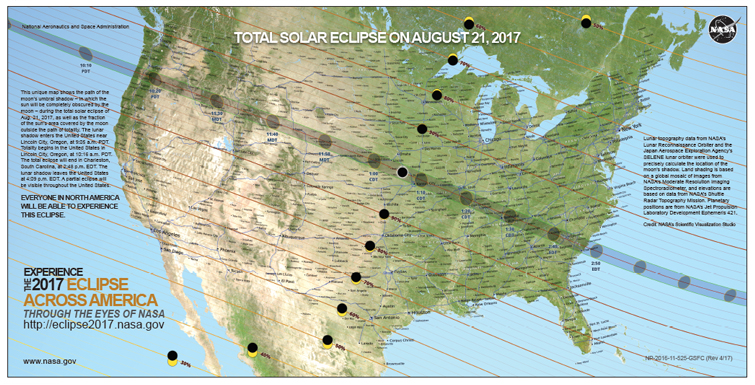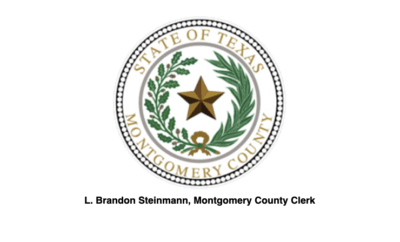
Calendar
10 Things to Know about the Solar Eclipse
It’s not every day we get to see a solar eclipse and on Monday, August 21, you have the opportunity to watch what they are calling “The Great American Total Solar Eclipse.”

NASA: A map of the United States showing the path of totality for the August 21, 2017 total solar eclipse.
Here are things you need to know:
- The solar eclipse is on Monday, August 21, 2017.
- The eclipse is a total solar eclipse where the moon appears to completely cover the sun in the sky.
- The total solar eclipse will be about 70 miles wide and stretch from Oregon to South Carolina, passing through Idaho, Wyoming, Nebraska, Kansas, Missouri, Illinois, Kentucky, Tennessee, Georgia, North Carolina and South Carolina. The following data chart provided by NASA displays the moment of mid-totality and the duration of totality for a handful of cities that lie close to the center of the path.
Eclipse Begins Totality Begins Totality Ends Eclipse Ends Madras, OR 09:06 a.m. 10:19 a.m. 10:21 a.m. 11:41 a.m. PDT Idaho Falls, ID 10:15 a.m. 11:33 a.m. 11:34 a.m. 12:58 p.m. MDT Casper, WY 10:22 a.m. 11:42 a.m. 11:45 a.m. 01:09 p.m. MDT Lincoln, NE 11:37 a.m. 01:02 p.m. 01:04 p.m. 02:29 p.m. CDT Jefferson City, MO 11:46 a.m. 01:13 p.m. 01:15 p.m. 02:41 p.m. CDT Carbondale, IL 11:52 a.m. 01:20 p.m. 01:22 p.m. 02:47 p.m. CDT Paducah, KY 11:54 a.m. 01:22 p.m. 01:24 p.m. 02:49 p.m. CDT Nashville, TN 11:58 a.m. 01:27 p.m. 01:29 p.m. 02:54 p.m. CDT Clayton, GA 01:06 p.m. 02:35 p.m. 02:38 p.m. 04:01 p.m. EDT Columbia, SC 01:03 p.m. 02:41 p.m. 02:44 p.m. 04:06 p.m. EDT - What about us? Houston, Texas will only be able to view a partial eclipse starting approximately at 11:45 a.m. CDT, middle of the eclipse (the maximum amount of sun covered) at 1:15 p.m. CDT, and the partial eclipse will end around 2:45 p.m CDT. View NASA’s interactive map for more locations and times.
- During the total solar eclipse, the moon will completely cover the disk of the sun for around 2 minutes and 40 seconds.
- DO NOT look directly at the sun before and after the eclipse’s totality – OR during any part of the partial eclipse in Texas. Sunglasses will NOT protect your eyes from the eclipse.
- To view the eclipse, use “solar-viewing glasses” or “eclipse glasses” or “personal solar filters”, according to the safety recommendations from NASA. Locations in The Woodlands like Best Buy, Kroger, Walmart, and The Woodlands Children’s Museum have reported to sell eclipse glasses while supplies last.
- Eclipse watchers can also use cameras or telescopes fitted with approved white light solar filters or other safe methods.
- For the full eclipse experience, NASA’s live eclipse programming begins at 12 p.m. EDT (11 a.m. CDT), Monday, August 21.
- What’s next? The next North American total solar eclipse will be in 2024. South America will be able to watch a total solar eclipse on July 2, 2019 and again on December 14, 2020. Antarctica will experience a total eclipse on December 4, 2021.
To learn more, NASA created a website dedicated to the 2017 Eclipse including downloadable information and live updates at https://eclipse2017.nasa.gov/
Sources:
NASA https://eclipse2017.nasa.gov/
Space.com https://www.space.com/33797-total-solar-eclipse-2017-guide.html
Great American Eclipse https://www.greatamericaneclipse.com/future/























